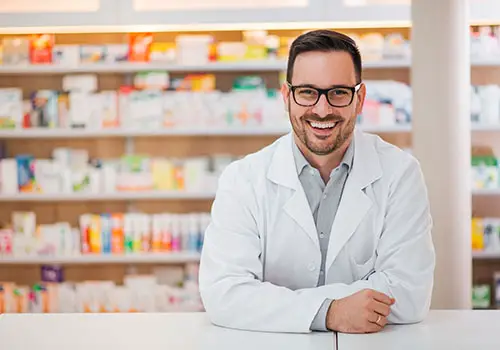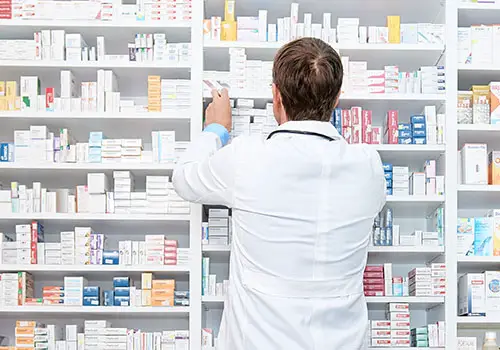How To Become A Pharmacist | 2022 Hiring Guide |

Any job in the medical field is lucrative and fulfilling, but not everyone is cut out to be a doctor or nurse. If you are interested in healthcare and have a keen curiosity in medicine itself, you might consider becoming a doctor of pharmacy. Pharmacists have a median pay of $128,710 per year. With steady job openings predicted over the next ten years, this is a viable career path to consider.
This rewarding profession requires many steps — just like most other jobs in the medical field. Below, you will find all of the essential steps to become a pharmacist and additional imperative information such as different types of pharmacy careers and how long it will take you.
Table of Contents
Requirements For Becoming A Pharmacist

— Education
One of the biggest things to consider when becoming a pharmacist is the amount of schooling required, which could take anywhere from six to eight years. Here are the three critical education requirements for success.
- After someone earns their high school diploma and chooses pharmacy as their career choice, they will need to obtain their pre-pharmacy undergraduate degree in a field such as biology or chemistry. (These four years can be split between two colleges. Some may prefer a community college for two years to achieve the first 60 credits before transferring). Make sure that you have completed all necessary prerequisite requirements for pharmacy school.
- Next, students must pass the Pharmacy College Admission Test, otherwise known as the PCAT. This specialized test is based on several categories, including writing, biological processes, chemical processes, critical reading, and quantitative reasoning.
- If the student passes the PCAT, they can apply for a pharmacy school to earn their doctoral degree through the PharmD program. Make sure the school is accredited by the Accreditation Council for Pharmacy Education. The program will include many specialized pharmaceutical sciences, including biochemistry, healthcare management, pharmacology, pharmacological measurements, pathology, and more.
— Licenses & Certifications
After completing the degree program coursework, aspiring pharmacists will need to acquire the necessary state licenses and certifications to begin working.
There are two essential exams for licensing:
While these are two of the most common exams for pharmacy students, certain states may have additional requirements. It’s essential to check with your state’s licensing board to learn about any other necessary exams.
Some states may also require specific documents before being allowed to take the test. Examples include a background check, internship proof, and additional postgraduate training.
Additional certifications will be necessary to perform specific tasks. For instance, a licensed pharmacist must pass a Pharmacy-Based Immunization Delivery program before becoming certified to provide vaccinations. The American Pharmacists Association offers this program, among others, including Medication Therapy Management and Patient-Centered Diabetes Care.
— Training
Training in the public health scope as a pharmacist is essential before working independently in pharmacy practice. While you have the option of on-the-job training programs, the most common course of action is a one or two-year residency program. These programs can be held in many facilities, such as hospital pharmacies and other healthcare settings.
The residency will add value to you if you consider a specialized position, for instance, oncology pharmacy or nuclear pharmacy.
— Skills
Becoming a pharmacist takes more than a bachelor’s degree, a doctor of pharmacy degree, and proper training. One must also have the right skills to be successful. Here are just a few of the most critical skills to equip:
- Detail-Oriented. A pharmacist needs to know the specifics of each medicine to be confident and safe when providing medicine to the public.
- Critical Thinking. Many individuals take more than one kind of prescription medication at a time, and it’s your job to understand which ones will work together without causing adverse side effects.
- Communication. Like other healthcare professionals, a pharmacist needs to have excellent communication skills. This is even more imperative for those in the pharmaceutical industry as they must relay crucial and potentially life-saving information to public health.
- Computer Knowledge. As a pharmacist, you’ll be using computers more than you’d think. Computers will be used for retrieving essential information for prescription medication while also being the go-to for confirming and billing insurance policies.
- Ability To Multitask. Whether you’re working in drug stores or hospitals, you will be busy serving customers, restocking, checking insurance policies, and more. Being able to multitask is critical.
- Strength In Science And Math. There’s a reason why pharmacists are required to have continuing education beyond the 4-year undergraduate; they need specific science and math skills. You will utilize this knowledge daily, so make sure you pay attention during class.
- Confidentiality. In terms of ethical skills, this one is the biggest. Keeping your patient’s medical records discreet is imperative whether you work in a small town or a metropolis.
- Mentoring. New pharmacists will likely enter your location during the duration of your career. You should help guide them and mold them into top-notch pharmacists.
Types Of Pharmacy Careers
— Pharmacist
The pharmacist is responsible for storing, preserving, and filling customers’ prescriptions. They are authorized to guide the public on using their medication and any potential side effects. Some are also allowed to give vaccinations and immunizations.
— Pharmacy Technician
A pharmacy technician works closely with the pharmacists. Their primary role is to prepare and fill customers’ prescription medications. They may perform slight clerical duties in their downtime, too.
— Pharmacy Assistant
A pharmacy assistant can also be referred to as a “clerk.” These individuals handle most of the administrative duties of the business, such as answering the phone and ringing up customers.
What Does A Pharmacist Do?

According to the U.S. Bureau of Labor Statistics, a pharmacist “dispenses prescription medications to patients and offers expertise in the safe use of prescriptions.” However, their duties extend beyond filling and providing medications. Pharmacists are also responsible for:
- Giving vaccinations and immunizations to the public
- Ensuring there are no side effects brought on by negative interactions or allergies
- Educating customers on the proper way to take their prescribed medicine
- Discussing the best course of action for patients
- Conducting wellness screenings
- Testing blood sugar and cholesterol levels
- Overseeing the technician and assistant, especially when working in own pharmacy
How Much Do Pharmacists Make?
The median pharmacist salary is $128,710 per year or $61.88 per hour. However, the amount earned per hour will vary depending on location. For example, pharmacists in California can easily make $139,690 while those in New Hampshire drop down to $127,350. Regardless of location, it’s clear that pharmacists — even those only working part-time — are well-paid.
How Long Does It Take To Become A Pharmacist?
Pharm D. programs (otherwise known as the essential program to become a pharmacist) take four years to complete. Before being admitted into the Pharm D. programs, aspiring pharmacists will need to complete their bachelor’s degree (four years) or complete two to three years of undergraduate education. That said, schooling alone will take anywhere from six to eight years.
You can’t forget the necessity for postgraduate training. In fact, most states will not allow a potential pharmacist to take the exams before completing at least a year or two of training.
Steps For Becoming A Pharmacist
#1. What You Will Need
All you need to start your journey to becoming a pharmacist is your high school diploma. Then, you can decide whether you will attend a two-year or four-year college (or a combination of both).
#2. Enroll In Post-Secondary Science Courses
Throughout your two to four years of continuing education, you will need to complete specific prerequisites to be accepted into the pharmacy program. These include General Chemistry, Organic Chemistry, Biology, Physiology, Physics, Microbiology, and more. Speak with the director of admissions to discuss which courses are essential to your acceptance.
#3. Take The Pharmacy College Admissions Test (PCAT)
The PCAT is a specialized test with 192 multiple choice questions and one essay question. The test measures many categories, including writing, biological processes, chemical processes, critical reading, and quantitative reasoning. Most aspiring pharmacists should take around two to six months to prepare for the test. The ideal score is above 400 (out of 600).
#4. Enroll In A Pharmacy Program
Your final step (for education requirements, at least) is to enroll in an accredited pharmacy program. Here is a comprehensive list of accredited pharmacy programs across the country.
#5. Pass State Pharmacy Licensure Exam
Upon completing your pharmacy program, you must pass a licensure exam. The two exams include the (NAPLEX) North American Pharmacist Licensure Exam and the (MPJE) Multistate Pharmacy Jurisprudence Exam.
#6. Complete Required Training
You have the option for on-the-job training, but residency for a year or two is highly recommended and will provide the best real-life experience for your future as a pharmacist. The residency will also be necessary to open up specialized pharmaceutical fields.
What To Expect After Becoming A Pharmacist
While the BLS does not declare growth in this field, many job openings are projected over the next ten years. After becoming a certified pharmacist, you can take a job at many different locations, from drug stores to hospitals. Some may want to continue their education and join a specialty pharmaceutical field, such as:
- Community Pharmacist
- Government Pharmacist
- Hospital Pharmacist
- Military Pharmacist
- Research Pharmacist
- Wholesale Pharmacist
- Critical Care Pharmacy
- Nuclear Pharmacy
- Nutrition Support Pharmacy
- Oncology Pharmacy
- Pediatric Pharmacy
- Psychiatric Pharmacy
The Bottom Line
A pharmacist is one of many healthcare jobs that are rewarding and well-paid. The career path requires at least six years of schooling, although eight is more common. You will also need to undergo training for a year or two before completing your exam and becoming a certified pharmaceutical. With a grand salary and steady job openings, it is an excellent career choice worth the time, money, and effort.
Frequently Asked Questions
What is the fastest way to become a pharmacist?
There is no fast track to becoming a pharmacist. The smallest amount of schooling time necessary is six years. This can be completed with a pre-pharmacy program, which takes approximately two years, rather than a full bachelor’s degree, which takes four.
Is it hard to become a pharmacist?
It can be challenging to become a pharmacist due to schooling and which classes are necessary for completion. For example, courses such as physiology and chemistry aren’t easy for most individuals. You will likely need to spend a decent amount of time studying.
What is the difference between a pharmacist and a chemist?
Although the terms “pharmacist” and “chemist” are frequently used interchangeably, they are entirely different things (at least this is true in the United States). A pharmacist is a healthcare professional that has trained in pharmaceuticals specifically. They understand how to dispense prescription medications safely and effectively.
On the other hand, a chemist is someone who studies chemistry specifically. They use chemical substances to conduct a wide range of research and experiments.
